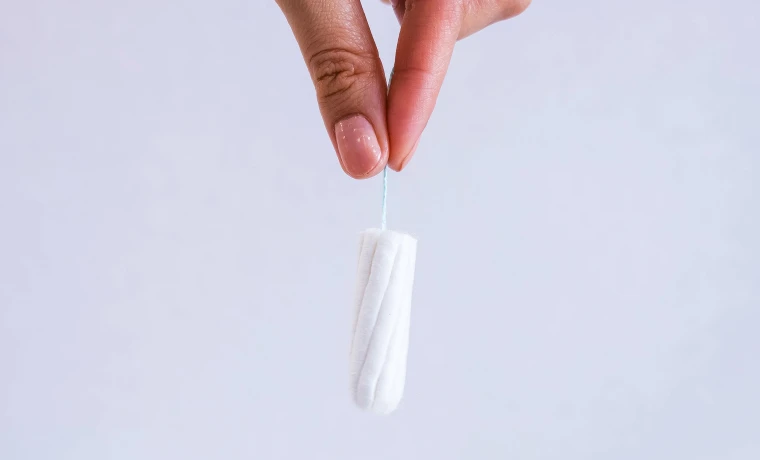For many who use tampons during their menstrual cycle, the experience is marked by a learning curve: finding the right fit, mastering insertion, and, frustratingly, dealing with leaks. One particularly perplexing issue is when a tampon leaks despite not being fully saturated. This can lead to discomfort, inconvenience, and anxiety, undermining the confidence of those who prefer this method of menstrual management. Understanding why this happens is crucial, not only for peace of mind but also for ensuring comfort and protection during menstruation.
Tampons are designed to be a convenient and discreet way to manage menstrual flow. They come in various sizes and absorbency levels to accommodate the wide range of flows experienced by menstruators across the globe. However, the effectiveness of a tampon isn’t solely dependent on its design or the materials from which it’s made. Several factors, including the user’s anatomy, the tampon’s fit and insertion, and the nature of the menstrual flow itself, play critical roles in how well a tampon performs its job.
The issue of tampons leaking when not full is a common concern that raises several questions. Why does this happen? Is it indicative of a problem with the tampon, or is it related to how it’s being used? Could it be a sign that a different menstrual product would be more suitable?
Recommended: Does Sex Affect Periods?
This guide aims to address these questions by exploring the various reasons behind this phenomenon. By demystifying the causes of tampon leaks, we hope to empower readers with the knowledge to make informed decisions about their menstrual health and product choices, leading to a more comfortable and confident menstrual experience.
Understanding Tampons and Their Function
Tampons are a popular menstrual product designed for internal use, offering an alternative to pads for managing menstrual flow. They are made from absorbent materials, typically cotton, rayon, or a blend of both, and are inserted into the vagina to absorb menstrual blood directly at the source.
Tampons are favored by many for their convenience, discreetness, and ability to allow for active lifestyles during menstruation. However, to maximize the benefits of tampons, it’s essential to have a solid understanding of how they work and the various factors that influence their performance.
What Tampons Are Made Of
Tampons consist of a compressed layer of absorbent material, designed to expand and conform to the vaginal canal’s shape as they absorb menstrual fluid. The materials used are chosen for their absorbency and comfort. Some tampons also come with an applicator, made from plastic or cardboard, to aid in insertion.

How Tampons Work
Once inserted, a tampon works by absorbing the menstrual blood before it leaves the vagina. The absorbent material expands as it soaks up fluid, creating a temporary barrier that helps prevent leaks. The efficiency of this process depends on the tampon’s absorbency level, the fit within the vagina, and the consistency and volume of the menstrual flow.
Different Sizes and Absorbency Levels
Tampons are available in various sizes and absorbency levels to accommodate different flow intensities and vaginal sizes. Common absorbency levels include light, regular, and super. Choosing the right tampon size and absorbency is crucial for preventing leaks and ensuring comfort. Using a tampon that’s too small or not absorbent enough for your flow can lead to leaks while using one that’s too large or too absorbent can cause discomfort and make removal difficult.
The Concept of “Fit”
The “fit” of a tampon refers to how well it conforms to the individual’s vaginal canal. A good fit is crucial for the tampon to function correctly. Factors that influence fit include the tampon’s size, the user’s anatomy, and the tampon’s expansion as it absorbs menstrual blood. A tampon that fits well will be comfortable, stay in place, and effectively absorb menstrual flow, reducing the risk of leaks.
Recommended: Does Ovulation Make You Emotional?
Understanding these aspects of tampons and their function is the first step towards troubleshooting issues like leaking when the tampon isn’t full. By choosing the right tampon for one’s needs and ensuring proper insertion, users can improve their experience with this menstrual product. However, even with this knowledge, it’s normal to encounter challenges, which is why it’s important to explore the common reasons behind tampon leaks and how to address them.
Common Reasons Why Tampons Leak When Not Full
Tampon leakage, despite the tampon not being fully saturated, can be perplexing and frustrating. Understanding the common reasons behind this issue can help users address and prevent leaks, improving their overall experience with tampons. Here are some of the most frequent causes of this problem and how to mitigate them:
1. Incorrect Size or Absorbency Level
One of the primary reasons for tampon leaks is using a tampon with an inappropriate size or absorbency level for your menstrual flow. If a tampon is too small or not absorbent enough, it may become overwhelmed by your flow before it can fully expand, leading to leaks. Conversely, a tampon that’s too large or too absorbent for your needs may not fit snugly in the vaginal canal, creating gaps that allow fluid to bypass the tampon.
Solution: Track your menstrual flow to understand your heavy and light days. Use tampons with an absorbency level that matches your flow, switching to higher or lower absorbency as needed. If leaks persist, experiment with different sizes to find a better fit.
2. Improper Insertion
Improper insertion can prevent a tampon from being positioned correctly in the vaginal canal, which is essential for optimal absorption. If a tampon is not inserted deeply enough, or if it’s angled incorrectly, it may not fully contact the menstrual flow, causing leaks.
Solution: Follow the instructions on the tampon packaging carefully. Use an applicator for more precise insertion if needed. Ensure the tampon is inserted deeply enough into the vagina, aiming towards the small of your back rather than straight up.
3. Positioning and Anatomical Differences
Every person’s anatomy is unique, and differences in vaginal shape and size can affect how well a tampon fits and functions. Additionally, the position of the cervix can change throughout your menstrual cycle, potentially impacting tampon efficiency.
Solution: If you suspect anatomical differences are causing leaks, consider trying tampons from different brands or those designed for different body types. Some products are specifically designed to accommodate anatomical variations.
4. Saturation Pattern
Tampons may not always absorb fluid evenly, leading to saturation in one area while other parts remain dry. This uneven absorption can cause the tampon to leak before it’s fully saturated.
Solution: Regularly check your tampon and change it if you notice it’s becoming saturated in one area. Rotating the tampon slightly upon insertion can sometimes help promote more even absorption.
5. Physical Activity
Movement and physical activity can cause a tampon to shift in the vagina, potentially creating gaps or altering its position so it no longer intercepts the menstrual flow effectively.
Solution: Opt for tampons designed for active use, which are made to fit more securely and withstand movement. Consider wearing a backup form of protection, such as a panty liner, during physical activities.
Recommended: How To Get Rid Of Smelly Discharge During Pregnancy
By understanding these common reasons for tampon leaks and implementing the suggested solutions, users can significantly reduce the occurrence of leaks, even when the tampon isn’t full. This knowledge empowers women to feel more confident and comfortable during their menstrual cycle, allowing them to choose tampons as a reliable form of menstrual management.

Additional Factors to Consider
While the size, absorbency level of the tampon, and correct insertion technique are crucial in preventing leaks, there are other factors that can influence tampon performance. Being aware of these can help users further tailor their menstrual care approach to their individual needs, potentially reducing the incidence of leaks even further.
1. Menstrual Flow Characteristics
The characteristics of your menstrual flow, including its consistency and the presence of blood clots, can affect how well a tampon absorbs menstrual blood. A very heavy flow with clots may not be absorbed as efficiently by a tampon, leading to leaks.
Solution: For those with heavy flows that include clots, it might be beneficial to use a tampon in conjunction with a backup method, such as a sanitary pad or menstrual cup, especially on heavy days. Regularly changing your tampon can also help manage a heavy flow more effectively.
2. Tampon Quality
Not all tampons are created equal. The quality of the tampon, including the materials used and the manufacturing process, can impact its absorbency and how well it expands to fit the vaginal canal.
Solution: Opt for reputable brands that use high-quality materials. Read reviews and consider recommendations from trusted sources to find products known for their reliability and performance. Trying different brands and types may be necessary to find the best fit for your body and flow.
3. Vaginal pH and Microbiome Health
The health of your vaginal flora and pH balance, though not directly related to tampon absorbency, can influence your overall comfort and susceptibility to irritation or infection. Tampon use, especially with super absorbent products, can affect vaginal pH and microbiome health.
Solution: To maintain a healthy vaginal environment, consider using tampons made from organic and natural materials that are less likely to cause irritation. Also, ensure you’re changing your tampon regularly, every 4 to 8 hours, to support vaginal health.
4. Personal Comfort and Sensitivity
Personal comfort and sensitivity to materials can also play a role in tampon use. Some individuals may find certain tampons uncomfortable or may experience sensitivity to the materials used in tampons, which can influence their choice of product and how often they change it.
Solution: If you experience discomfort or sensitivity, look for tampons made from hypoallergenic and organic materials that are free from fragrances and dyes. Test different brands to find one that offers both comfort and effective protection.
Recommended: Can I Take Magnesium While Breastfeeding?
By considering these additional factors, you can make more informed decisions about your menstrual care, leading to better overall satisfaction with tampon use. Understanding the nuanced ways in which various elements can affect tampon performance allows users to proactively address and prevent leaks, ensuring a more comfortable and confident menstrual experience.
Alternatives and Solutions
While tampons are a popular choice for menstrual management, they are not the only option available. Understanding the alternatives and supplementary strategies can help individuals find the best solution for their needs, especially if they continue to experience leaks or are looking for added security.
1. Using the Right Product for Your Needs
Choosing the right menstrual product is crucial for comfort and leak prevention. This choice will depend on your lifestyle, flow, and personal preferences.
Solution: Assess your needs based on your daily activities, the heaviness of your flow, and comfort preferences. Consider trying different products to find the one that best suits your lifestyle.
2. Combination Strategies
For those who prefer tampons but need extra protection, especially on heavy-flow days or during physical activities, using a combination of products can offer peace of mind.
- Panty Liners and Sanitary Pads: Wearing a panty liner or a thin sanitary pad along with a tampon can catch any leaks, providing double protection.
- Period Panties: These are designed to be worn as a backup to tampons or menstrual cups, or they can be used alone on lighter days. They come in various absorbency levels to suit different needs.
3. Considering Other Menstrual Products
Exploring other menstrual products can open up new possibilities for managing your period with more comfort and less worry about leaks.
- Menstrual Cups: These are reusable, flexible cups made from silicone or rubber that collect rather than absorb menstrual blood. They can hold more fluid than tampons, making them a great option for those with a heavy flow, and can be worn for up to 12 hours.
- Period Underwear: Designed to be worn without any other menstrual product, period underwear has built-in layers to absorb menstrual blood. They can be a comfortable alternative for those who prefer not to use internal products.
When to Consult a Healthcare Provider
Persistent issues with tampon leaks, discomfort, or any other menstrual concerns should be discussed with a healthcare provider. If you’re experiencing recurrent leaks despite trying different products and sizes, or if you have concerns about your menstrual flow or health, consult a healthcare provider. They can offer personalized advice and rule out any underlying conditions that might be affecting your menstrual health.
Embracing Flexibility and Personal Comfort
Ultimately, managing your menstrual cycle is about finding what works best for you, which may involve a process of trial and error. Be open to experimenting with different products and combinations thereof. Pay attention to how your body responds to these changes and adjust accordingly. Comfort, convenience, and confidence in your menstrual management choice are paramount.
Recommended: Can You Drink Gatorade While Pregnant?
In conclusion, while tampons are a convenient option for many, they are not the only solution for menstrual management. By understanding the range of products available and considering personal needs and preferences, women can find the best strategy for their bodies. This may involve using tampons in conjunction with other products, switching to alternative menstrual products entirely, or a combination of methods. The goal is to ensure that each person can navigate their menstrual cycle with confidence, comfort, and ease.
FAQs
Can the way I insert my tampon cause leaks?
Yes, improper insertion can lead to leaks. Ensure the tampon is inserted deeply enough into the vagina and positioned correctly to absorb menstrual flow effectively. Follow the instructions on the packaging or consult a healthcare provider for guidance.
How do I choose the right tampon size and absorbency?
Select a tampon based on the heaviness of your menstrual flow. Start with the lowest absorbency needed to manage your flow and adjust as necessary. If you experience leaks or discomfort, consider trying a different size or absorbency level.
Can physical activity affect tampon performance?
Yes, movement and physical activity can cause a tampon to shift, potentially leading to leaks. Consider using tampons designed for active use or adding a backup form of protection, such as a panty liner, during workouts or sports.
Why does my tampon leak on one side or in a specific area?
This can happen due to uneven absorption, where the tampon becomes saturated in one area while other parts remain dry. Regularly changing your tampon and ensuring it’s positioned correctly can help address this issue.
How often should I change my tampon to prevent leaks?
It’s recommended to change your tampon every 4 to 8 hours, depending on your flow. Adjust the frequency as needed for heavier or lighter days, and never leave a tampon in for more than 8 hours to reduce the risk of Toxic Shock Syndrome (TSS).
Can the type of tampon material affect leakage?
Yes, the quality and type of material can influence a tampon’s absorbency and how it expands. Opting for tampons from reputable brands and considering organic or hypoallergenic options may improve performance and comfort.
Is it normal for tampons to leak occasionally?
Yes, occasional leaks can happen, especially as you learn what works best for your body and menstrual flow. Utilizing backup protection and being prepared to change products as needed can help manage this issue.
Conclusion
Understanding why tampons leak when not full is crucial for addressing this common issue and enhancing menstrual comfort. By considering factors such as size, absorbency level, and insertion technique, alongside exploring alternative products and combination strategies, individuals can find tailored solutions to manage their menstrual cycle effectively.
Remember, every person’s experience with menstruation is unique, and it may take time to discover the best approach for your body. Embracing this journey with patience and openness ensures not only improved menstrual management but also a greater sense of confidence and well-being during your period.
